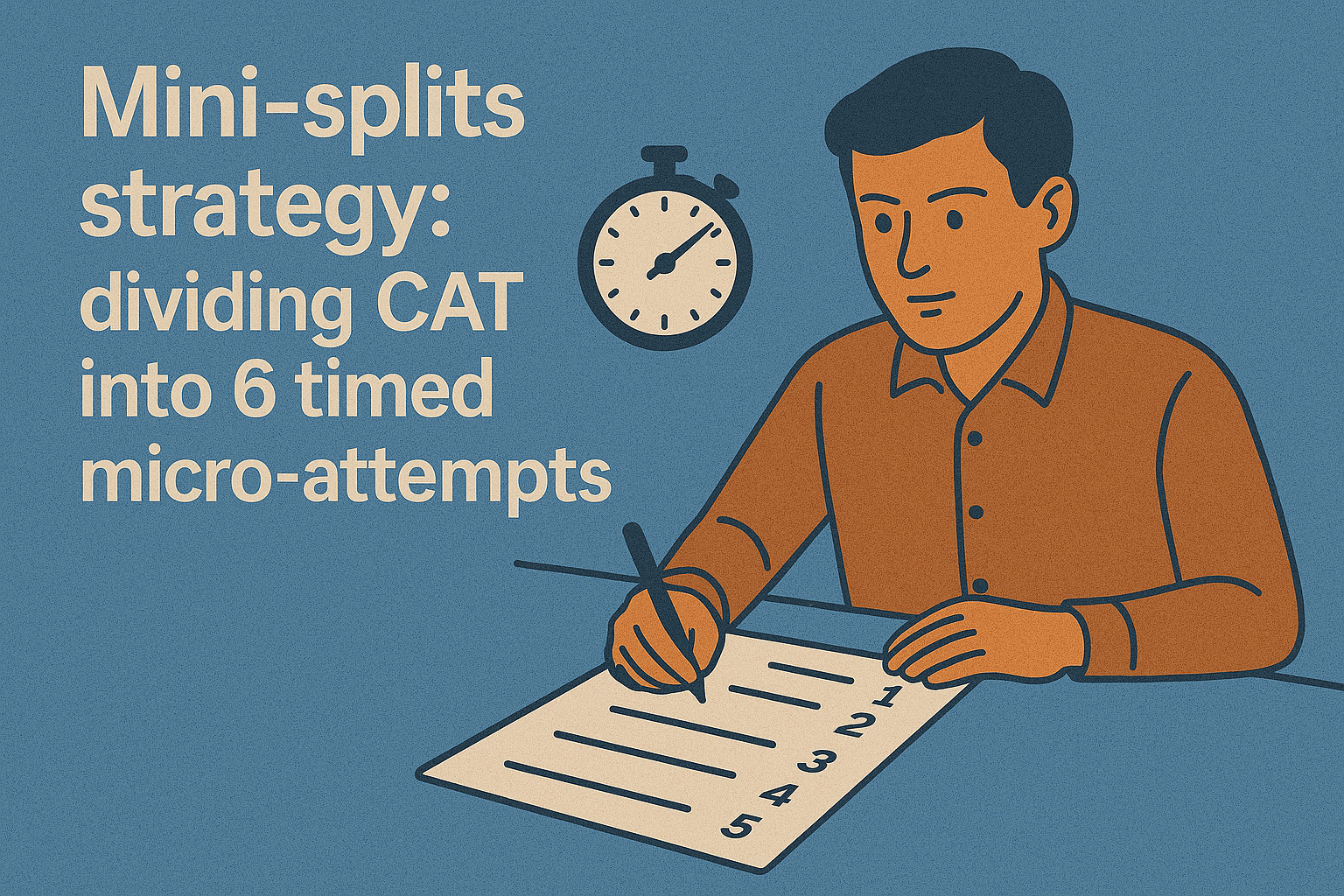Mini-splits strategy: dividing CAT into 6 timed micro-attempts

Preparing for the CAT exam can feel overwhelming, especially with its tightly packed three-section structure. As a student in India, I’ve found that traditional 3-hour mock attempts sometimes do more harm than good. That’s when I discovered the power of the "mini-splits strategy"—breaking the CAT exam into six focused micro-attempts to improve performance, accuracy, and mental endurance. Whether you're at the start of your preparation or nearing the CAT exam date, this strategy can refine your approach.
Why traditional full-length mocks may backfire
Full-length mocks are crucial, but attempting them without a refined approach can lead to burnout, underperformance, and inaccurate diagnostics. Most students treat mocks as monolithic sprints, when in reality, CAT demands a modular mix of speed, accuracy, and mental agility across varying question types and difficulties. Understanding the CAT exam pattern is vital to use this strategy effectively and pinpoint your weak zones before the CAT admit card is released.
What is the mini-splits strategy?
The mini-splits strategy involves dividing your CAT mock (or even actual study sessions) into six short, high-focus segments:
-
VARC slot 1 (18 mins) – focus on two RC passages or 4-5 VA questions based on the CAT exam syllabus
-
VARC slot 2 (18 mins) – attempt the remaining set with accuracy over speed
-
DILR slot 1 (20 mins) – solve 1 complete set or 2 half sets while simulating exam conditions
-
DILR slot 2 (20 mins) – attempt 1-2 more sets with a timer
-
QA slot 1 (22 mins) – solve 7-8 questions from a chosen topic based on syllabus weightage
-
QA slot 2 (22 mins) – focus on new/difficult topics or revisit wrong attempts to align with expected question types
Each micro-attempt mimics the actual exam condition but in a manageable time block. This style of prep can be started soon after submitting your CAT application form.
Benefits of using mini-splits
1. Improves focus
Short bursts reduce fatigue and boost concentration. You’re not mentally drained by the 2-hour mark, especially critical when you're close to your CAT exam date.
2. Encourages strategic pacing
Each segment pushes you to optimize attempts per minute, enhancing question selection and pacing—skills vital under the time constraints defined by the CAT exam pattern.
3. Better diagnostics
Reviewing performance per split gives sharper insights—did you peak early? Crash in DILR? Fade in QA? These diagnostics help tweak your preparation per the CAT exam syllabus.
4. Simulates exam tension
The timed mini-blocks create urgency without overwhelming you, ideal for building exam-day temperament and time management strategies before downloading your CAT admit card.
How to implement this in daily prep
-
Weekdays: do 2-3 splits daily from different sections aligned with the CAT exam syllabus
-
Weekends: try full 6-split sequences to simulate mocks and refine stamina
-
Use sectional tests: convert them into 2 mini-splits instead of one 40-minute run
-
Analyze split-wise: review mistakes, pacing, and question filtering for each block and adjust accordingly
Integrating with CAT preparation tools
This strategy complements traditional preparation. Whether you’re tracking progress by section, updating your plan based on the CAT exam syllabus, or exploring the latest changes to the CAT exam pattern, using mini-splits helps embed both precision and adaptability into your prep.
Also, while downloading your CAT admit card, noting your CAT exam date, or filling the CAT application form, your focus is on logistics. But when it comes to mental conditioning, the mini-splits strategy brings structure, rhythm, and resilience to your mock-taking journey.
Final thoughts
In a high-pressure exam like CAT, the way you take mocks is just as important as how much you study. The mini-splits strategy offers a smart, stamina-saving, analytics-driven method to simulate real exam conditions—minus the mental fatigue. It not only prepares you for the structure defined in the CAT exam pattern but also ensures you're aligned with the demands of the CAT exam syllabus. Give it a try, and you may just find yourself not only scoring better but also feeling more confident as you prepare to download your CAT admit card and approach the CAT exam date.
- Art
- Causes
- Crafts
- Dance
- Drinks
- Film
- Fitness
- Food
- Jocuri
- Gardening
- Health
- Home
- Literature
- Music
- Networking
- Alte
- Party
- Religion
- Shopping
- Sports
- Theater
- Wellness


